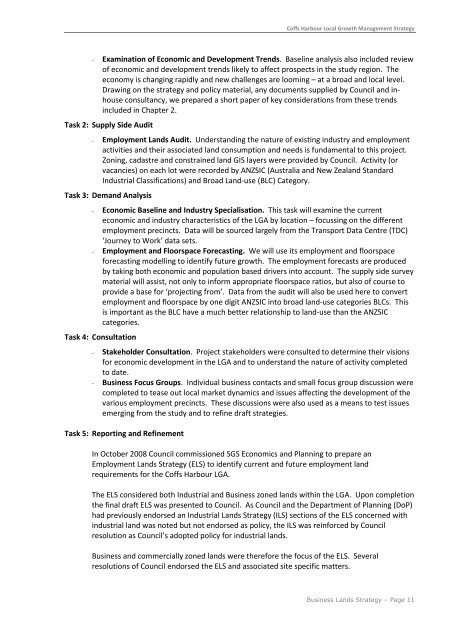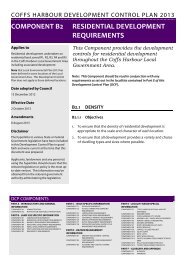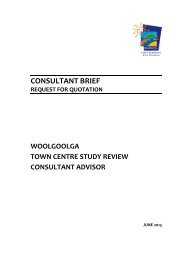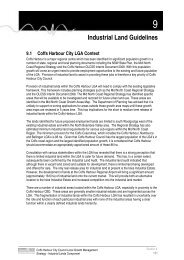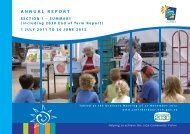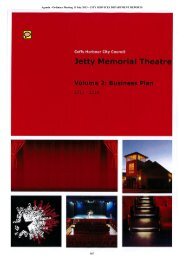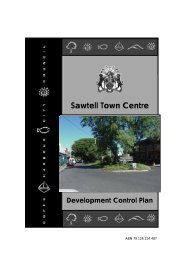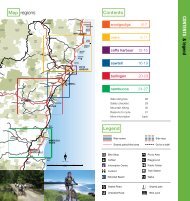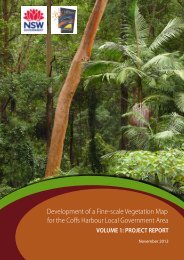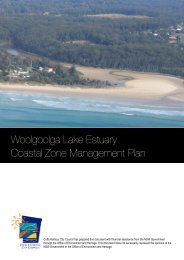Business Lands Strategic Plan - Coffs Harbour City Council - NSW ...
Business Lands Strategic Plan - Coffs Harbour City Council - NSW ...
Business Lands Strategic Plan - Coffs Harbour City Council - NSW ...
Create successful ePaper yourself
Turn your PDF publications into a flip-book with our unique Google optimized e-Paper software.
<strong>Coffs</strong> <strong>Harbour</strong> Local Growth Management Strategy<br />
−<br />
Examination of Economic and Development Trends. Baseline analysis also included review<br />
of economic and development trends likely to affect prospects in the study region. The<br />
economy is changing rapidly and new challenges are looming – at a broad and local level.<br />
Drawing on the strategy and policy material, any documents supplied by <strong>Council</strong> and inhouse<br />
consultancy, we prepared a short paper of key considerations from these trends<br />
included in Chapter 2.<br />
Task 2: Supply Side Audit<br />
−<br />
Employment <strong>Lands</strong> Audit. Understanding the nature of existing industry and employment<br />
activities and their associated land consumption and needs is fundamental to this project.<br />
Zoning, cadastre and constrained land GIS layers were provided by <strong>Council</strong>. Activity (or<br />
vacancies) on each lot were recorded by ANZSIC (Australia and New Zealand Standard<br />
Industrial Classifications) and Broad Land-use (BLC) Category.<br />
Task 3: Demand Analysis<br />
−<br />
−<br />
Economic Baseline and Industry Specialisation. This task will examine the current<br />
economic and industry characteristics of the LGA by location – focussing on the different<br />
employment precincts. Data will be sourced largely from the Transport Data Centre (TDC)<br />
‘Journey to Work’ data sets.<br />
Employment and Floorspace Forecasting. We will use its employment and floorspace<br />
forecasting modelling to identify future growth. The employment forecasts are produced<br />
by taking both economic and population based drivers into account. The supply side survey<br />
material will assist, not only to inform appropriate floorspace ratios, but also of course to<br />
provide a base for ‘projecting from’. Data from the audit will also be used here to convert<br />
employment and floorspace by one digit ANZSIC into broad land-use categories BLCs. This<br />
is important as the BLC have a much better relationship to land-use than the ANZSIC<br />
categories.<br />
Task 4: Consultation<br />
−<br />
−<br />
Stakeholder Consultation. Project stakeholders were consulted to determine their visions<br />
for economic development in the LGA and to understand the nature of activity completed<br />
to date.<br />
<strong>Business</strong> Focus Groups. Individual business contacts and small focus group discussion were<br />
completed to tease out local market dynamics and issues affecting the development of the<br />
various employment precincts. These discussions were also used as a means to test issues<br />
emerging from the study and to refine draft strategies.<br />
Task 5: Reporting and Refinement<br />
In October 2008 <strong>Council</strong> commissioned SGS Economics and <strong>Plan</strong>ning to prepare an<br />
Employment <strong>Lands</strong> Strategy (ELS) to identify current and future employment land<br />
requirements for the <strong>Coffs</strong> <strong>Harbour</strong> LGA.<br />
The ELS considered both Industrial and <strong>Business</strong> zoned lands within the LGA. Upon completion<br />
the final draft ELS was presented to <strong>Council</strong>. As <strong>Council</strong> and the Department of <strong>Plan</strong>ning (DoP)<br />
had previously endorsed an Industrial <strong>Lands</strong> Strategy (ILS) sections of the ELS concerned with<br />
industrial land was noted but not endorsed as policy, the ILS was reinforced by <strong>Council</strong><br />
resolution as <strong>Council</strong>’s adopted policy for industrial lands.<br />
<strong>Business</strong> and commercially zoned lands were therefore the focus of the ELS. Several<br />
resolutions of <strong>Council</strong> endorsed the ELS and associated site specific matters.<br />
<strong>Business</strong> <strong>Lands</strong> Strategy – Page 11


